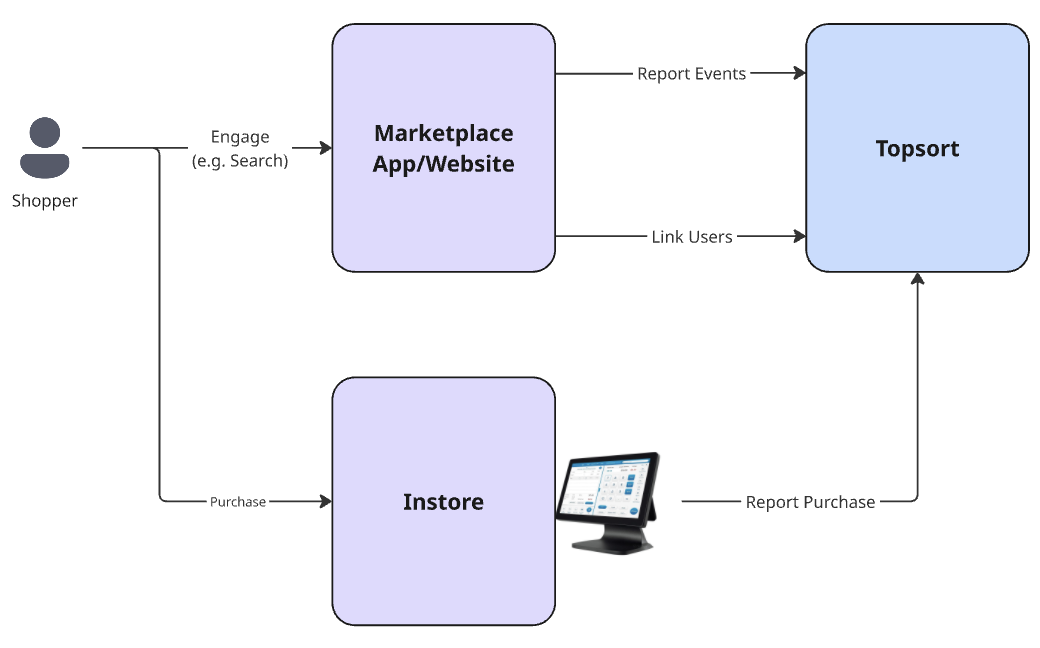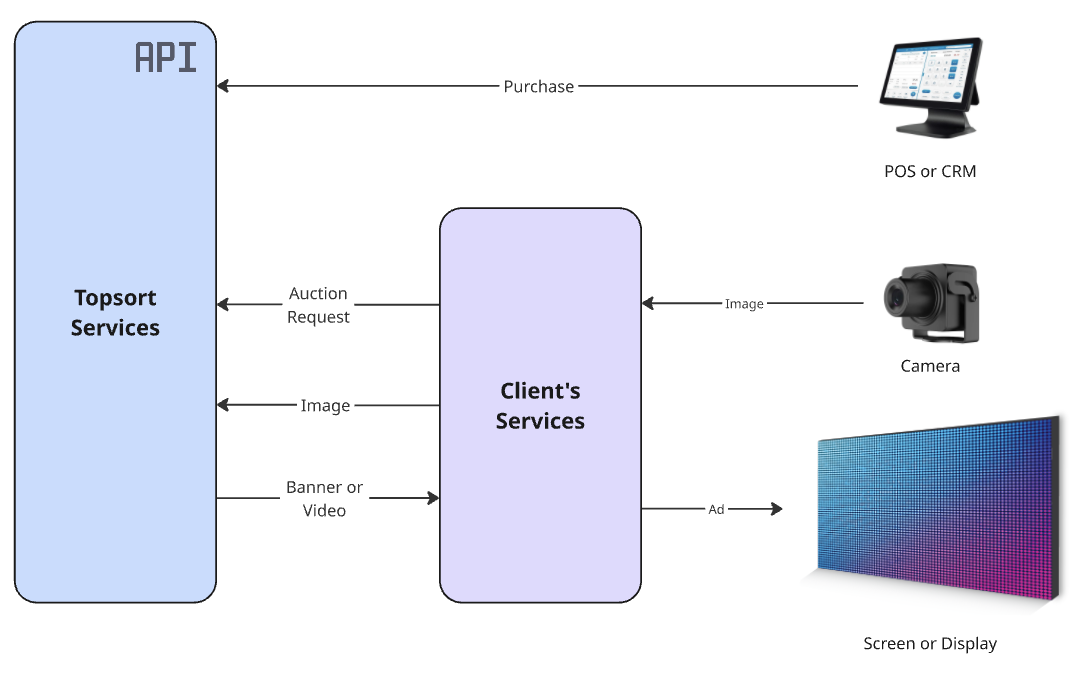Main Use Cases
Topsort offers different ways for retailers to use in-store ads, depending on your goals for showing ads, measuring audience, and tracking sales.
1. Onsite to In-Store Attribution
Onsite to Instore attribution lets Topsort connect ads seen online (on your website or apps) to actual purchases made instore.
How It Works:
- Reporting Online Interactions and Instore Purchases: Retailers send to Topsort clicks and impressions made on the online ads, and purchases made in their stores, using the Events API.
- Linking Users: To know which online ad led to an instore sale, the retailers can use our Linking Users API. This helps match a person’s online activity with their instore buying.
This process helps businesses see how well their online ads encourage people to visit and buy products in their physical stores. Topsort can also track sales of related items, giving a fuller picture of how well ads are working.

2. Ad Display Only
This option is suitable for clients who wish to display ads on their in-store screens using Topsort’s auction platform. The primary focus is on showing ads, without detailed audience measurement or direct sales attribution.

3. Ad Display with Audience Optimization
In this case, a key feature is the ability to measure the audience viewing each screen. This is done by sending images from a camera to Topsort for audience measurement.
Ads serving is optimized based on information from these images. The images can be used to estimate the audience’s presence and general demographics, which helps decide which ad to show. This option does not track sales, and clients do not share their purchase data.

4. Ad Display with Direct Sales Attribution (Small Store Focus)
This use case builds upon the “Ad Display with Audience Optimization” by adding direct sales attribution, making it particularly good for smaller retail environments. In this scenario, clients still utilize screens for ad display, powered by Topsort’s auction platform, and measure audience presence using cloud-based image processing from cameras. The primary distinction is the integration of purchase data from the client’s POS (Point of Sale) or CRM systems.
The system continues to display ads based on real-time image analysis, with images triggering both auction requests and audience/demographic estimations. The audience measurement remains limited to individuals detected in the trigger image. However, because the store is sufficiently small, direct attribution of sales can be achieved without the need for a complex user tracking model. This allows for direct attribution within a short timeframe after ad exposure.

5. Static Ads with Customer Journey and Sales Attribution (Medium to Large Stores)
This option is designed for clients managing medium to large stores with multiple areas of interest. The primary focus is on displaying static advertisements, with no requirement for ad auctions. Clients aim to compute customer paths within the store and attribute sales to specific ads. A key aspect of this solution is its on-premises operation, and clients can send their purchase data to Topsort.
The system utilizes an in-store image processing server that receives images from IP cameras every few seconds. This image data is used to estimate audience presence and optional group demographics. A multicamera tracking module assigns a unique track ID to each person in the store. To enable accurate sales attribution, cameras or sensors are strategically positioned near Points of Sale (POS) to match customer presence with purchase data. The system logs audience presence events and processes purchase data from the client’s CRM or other sources. This setup allows for comprehensive tracking of products of interest, rather than auction-based campaigns.
6. Dynamic Ads with Advanced Customer Journey and Sales Attribution (Medium to Large Stores)
This is an advanced option for medium to large stores, building upon the capabilities of Case 4. Clients in this scenario have dynamic ads displayed on screens and wish to leverage Topsort’s auction platform to show these ads. A key requirement is precise audience measurement, along with the ability to filter out specific individuals, such as store staff or shoppers without empty carts, from the audience data.
The system uses an in-store image processing server that continuously receives images from IP cameras. These images are processed to detect people in ad exposure zones, estimate audience demographics (optionally), and track individuals across multiple cameras within the store. Object detection and classification are employed to filter or add metadata to presence events, meeting client-specific needs. Calls for ad auctions are made to the Auction Endpoint, while audience presence events are logged via the Presence Endpoint. Purchase data from the client’s CRM or other POS systems is sent to the Purchase Endpoint. Cameras or sensors are positioned near Points of Sale (POS) to match customer presence with purchase data, enabling robust sales attribution.